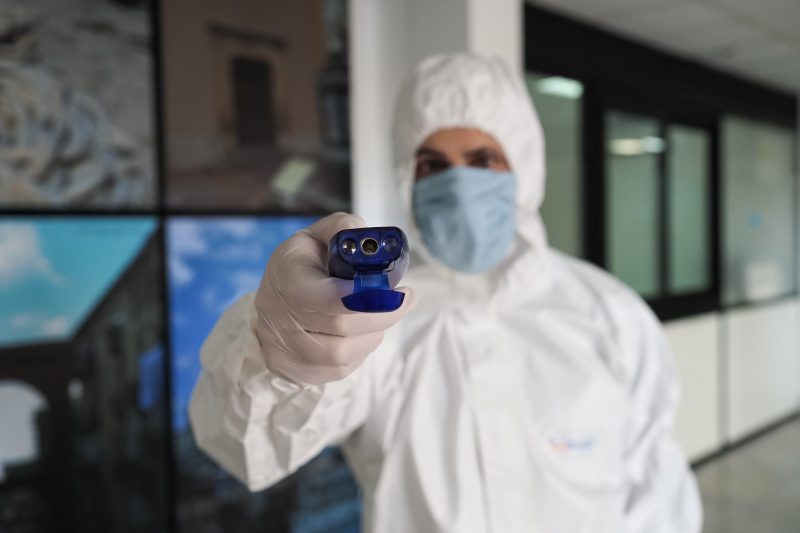- The majority of coronavirus patients develop a fever, based on research from China and the US.
- But using thermometers or thermal cameras to check people’s temperature isn’t a foolproof method for identifying cases.
- Temperature checks don’t identify patients who are asymptomatic, pre-symptomatic, or experiencing symptoms other than a fever.
- Visit Business Insider’s homepage for more stories.
Since the early days of the coronavirus pandemic, airport screeners have relied on temperature checks to detect cases among travelers. The method is now being used to spot potential infections in countries that have relaxed lockdown restrictions.
In Wuhan, China, government officials use thermometers to screen people on subways and at the entrances to grocery stores, malls, and office buildings. South Korea recently checked temperatures at polling stations during the nation’s parliamentary elections. Italy is also using drones equipped with heat sensors to identify areas with high body temperatures in the northern province of Bergamo. From there, authorities test residents within an individual hotspot using a thermometer.
US cities and states are considering a temperature-taking approach, too.
California Gov. Gavin Newsom told Politico on April 14 that the state might deploy temperature checks at the doors of restaurants when it reopens. A few days later, New York City Mayor Bill de Blasio told MSNBC that workplaces might require temperature checks for employees once the city’s lockdown lifts.
Since April 2, Amazon has been using thermal cameras to temperature check more than 100,000 employees per day at warehouses. Anyone with a temperature above 100.4 degrees Fahrenheit is sent home and asked not to return until their fever has been gone for three days.
But fever screenings miss a large swath of infections.
Anthony Fauci, director of the National Institute of Allergy and Infectious Disease, recently estimated that between 25% and 50% of people infected with the coronavirus never show symptoms. A person's symptoms also may not appear until two to 14 days after their exposure to the virus, according to the US Centers for Disease Control and Prevention. This leaves a window during which a person can be contagious but still have a normal body temperature.
Plus, not all coronavirus patients develop a fever. And even when someone is running a fever, tools used to measure their temperature aren't always accurate. That means temperature checks are far from foolproof.
A quarter of US hospitalized cases didn't have a fever
In the largest overview of coronavirus symptoms so far - a February report from the World Health Organization - around 88% of patients developed a fever out of nearly 56,000 laboratory-confirmed cases in China. The virus' two other main symptoms, cough and shortness of breath, were less common: Coughs developed among 68% of patients, and around 20% of patients experienced shortness of breath.
However, a preliminary, internal Trump administration report obtained by the New York Times found that a fever wasn't as ubiquitous among hospitalized patients in the US.
Out of more than 2,500 US patients hospitalized from March 1 to May 1, around 75% presented a fever and chills, according to the document. The same percentage of patients developed a cough, and 70% experienced shortness of breath.
Another study of 5,700 hospitalized patients in New York City found that only one-third of the patients developed a fever. This suggests that fevers may be weaker indicators of a coronavirus infection than scientists previously thought.

Jim Collins, a bioengineering professor at MIT, told Business Insider that temperature checks are "an easy-to-use means" of screening, but they have a "very low" capacity to identify most coronavirus cases.
"You can have a fever for a lot of reasons," he said. "Maybe you ran to work or you rode a bike and your temp goes way up, or you have any number of strains of flu or a cold or strep throat."
Medications like aspirin or ibuprofen can also lower a person's temperature, presenting another opportunity for an infected patient to slip through the cracks.
"Fever screening can be one part of a wider system, but it's still unclear how much marginal benefit there is," Amesh Adalja, a senior scholar at the Johns Hopkins Center for Health Security, recently told Health.com.
Thermometers aren't always accurate, but alternatives are limited
The effectiveness of temperature checks also depends on the device and the conditions under which it's used.
Chinese officials often use infrared thermometers, which can produce a false reading if they're too close or too far from a person's forehead. That's because the device measures surface temperature - the amount of heat emanating from a person's skin - as opposed to internal body temperature. As a result, a person's temperature reading may rise or fall if the check is performed outdoors in particularly hot or cold climates.
The device used by Amazon, thermal cameras, can offer more accurate readings from farther away, but they're more expensive and there's a risk of supply shortages, Reuters recently reported.
Collins' lab is working to create a more direct approach to identifying cases: a face mask with sensors that could detect coronavirus particles when a person speaks, coughs, sneezes, or breathes. But the product is still in the research phase and hasn't been manufactured yet.
For now, temperature checks offer a feasible method for identifying some infected people, even if they're unlikely to catch every case.










